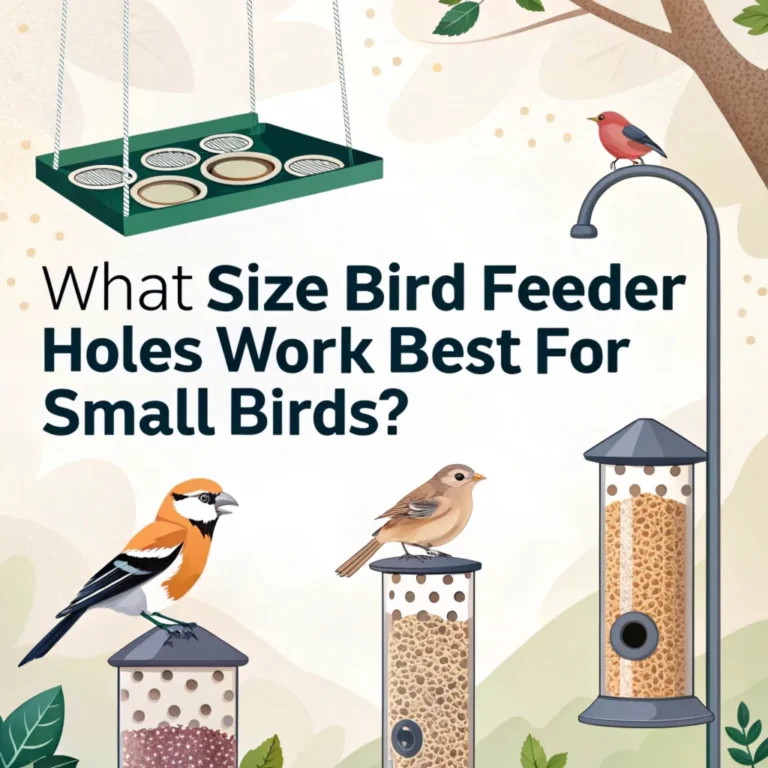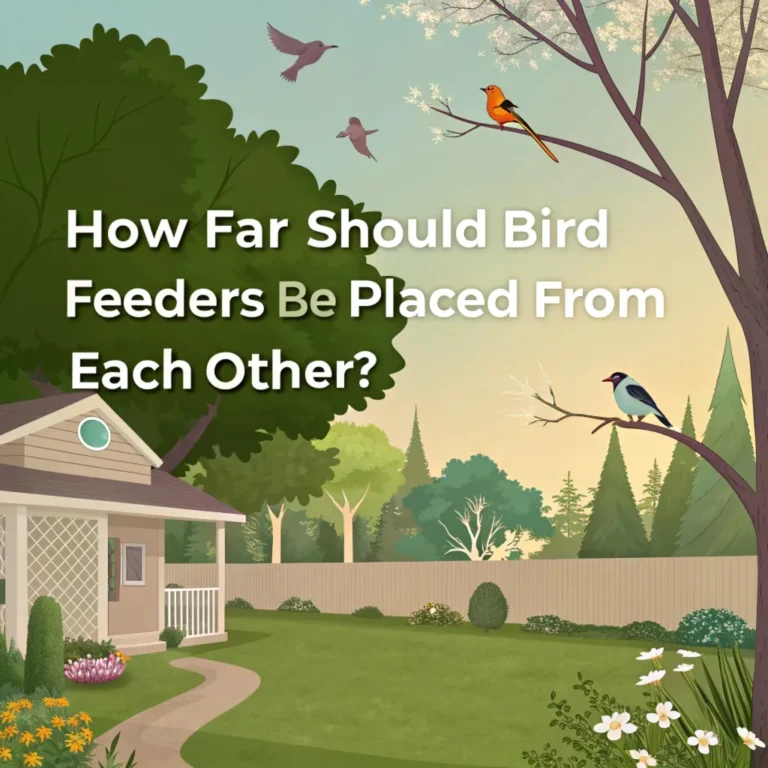When is the Best Time to Fill Bird Feeders During Winter?
Winter bird feeding is a crucial activity for bird enthusiasts and conservationists alike.
As natural food sources become scarce, providing supplementary nutrition can make a significant difference in the survival and well-being of our feathered friends.
This comprehensive guide will explore the optimal times and methods for winter bird feeding, ensuring you can support your local avian population effectively.
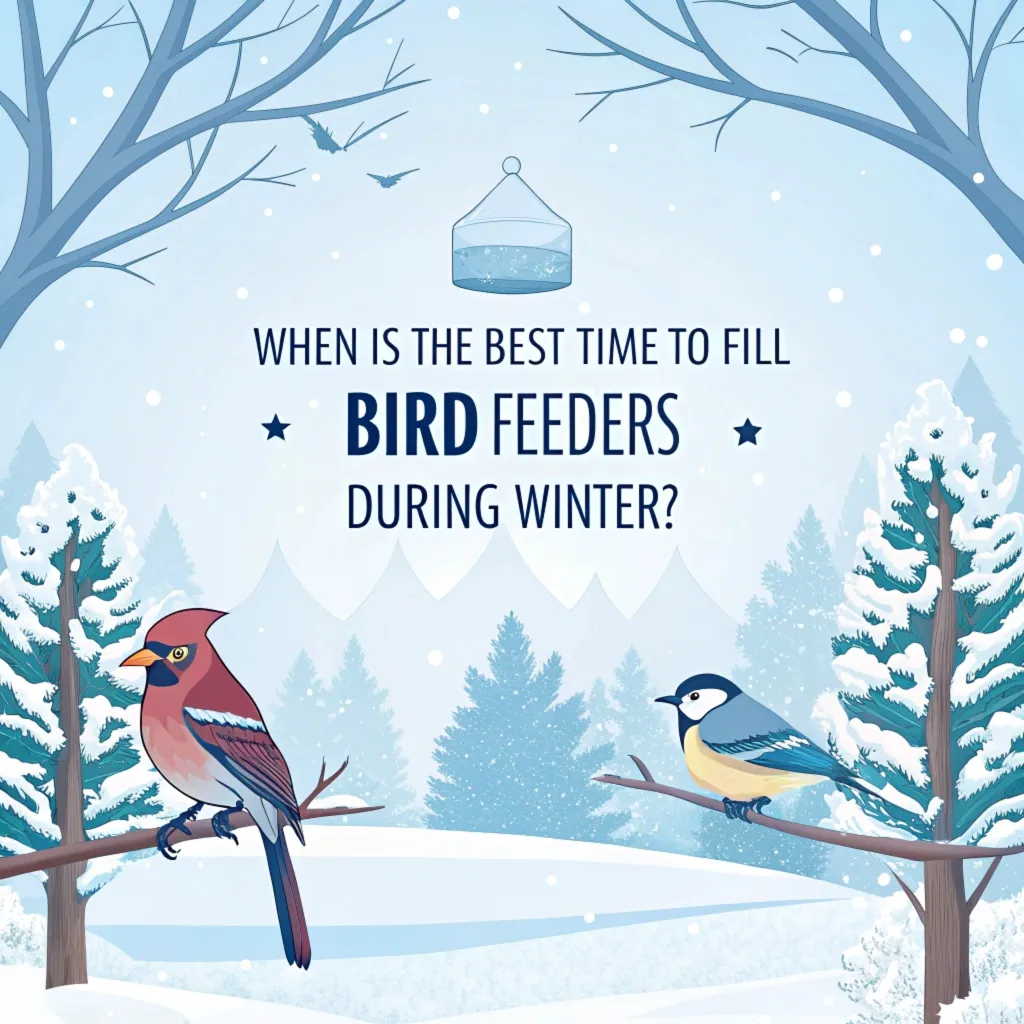
Key Takeaways: Winter Bird Feeding Essentials
- Winter is the most critical time for bird feeding due to scarce natural food sources
- Fill feeders daily, preferably in the early morning
- Offer high-energy foods like black oil sunflower seeds, suet, and peanuts
- Provide fresh water alongside food sources
- Clean feeders regularly to prevent disease spread
- Place feeders in sheltered areas away from harsh winds
- Continue feeding consistently throughout the winter season
- Offer a variety of food types to attract different bird species
- Monitor feed levels frequently, especially during severe weather
- Consider using heated bird baths to provide unfrozen water
- Start feeding in late fall to help birds prepare for winter
- Maintain feeders until natural food sources become abundant in spring
Understanding Winter Bird Feeding Patterns
Birds require more energy during winter to maintain their body temperature and survive cold nights. This increased energy demand makes winter the most critical time for supplementary feeding.
As natural food sources like insects and berries become scarce, birds rely heavily on alternative food sources to meet their nutritional needs.
Winter feeding plays a vital role in supporting bird populations during harsh weather conditions. By providing a reliable food source, we help birds conserve energy they would otherwise spend searching for scarce natural foods.
This support can significantly improve survival rates and ensure birds are in better condition when the breeding season arrives.
The consistency of feeding is crucial. Birds quickly learn to rely on feeders as part of their daily foraging routine. A sudden absence of food can force them to expend precious energy seeking new food sources.
The Ideal Time to Fill Bird Feeders in Winter
The best time to fill bird feeders during winter is early in the morning. Birds typically feed heavily in the morning to replenish energy lost during the cold night.
By filling feeders at dawn or just before, you ensure that food is available when birds need it most.
Timing is crucial in winter bird feeding. Birds have adapted to forage efficiently during daylight hours, with peak activity occurring in the early morning and late afternoon.
These periods align with their need to stock up on calories before and after the long, cold nights.
Filling feeders early also allows you to observe bird behavior and ensure the feeders are functioning properly in cold conditions. This observation can enhance your enjoyment of birdwatching while ensuring that your feeding efforts are effective.
Frequency of Feeder Refills
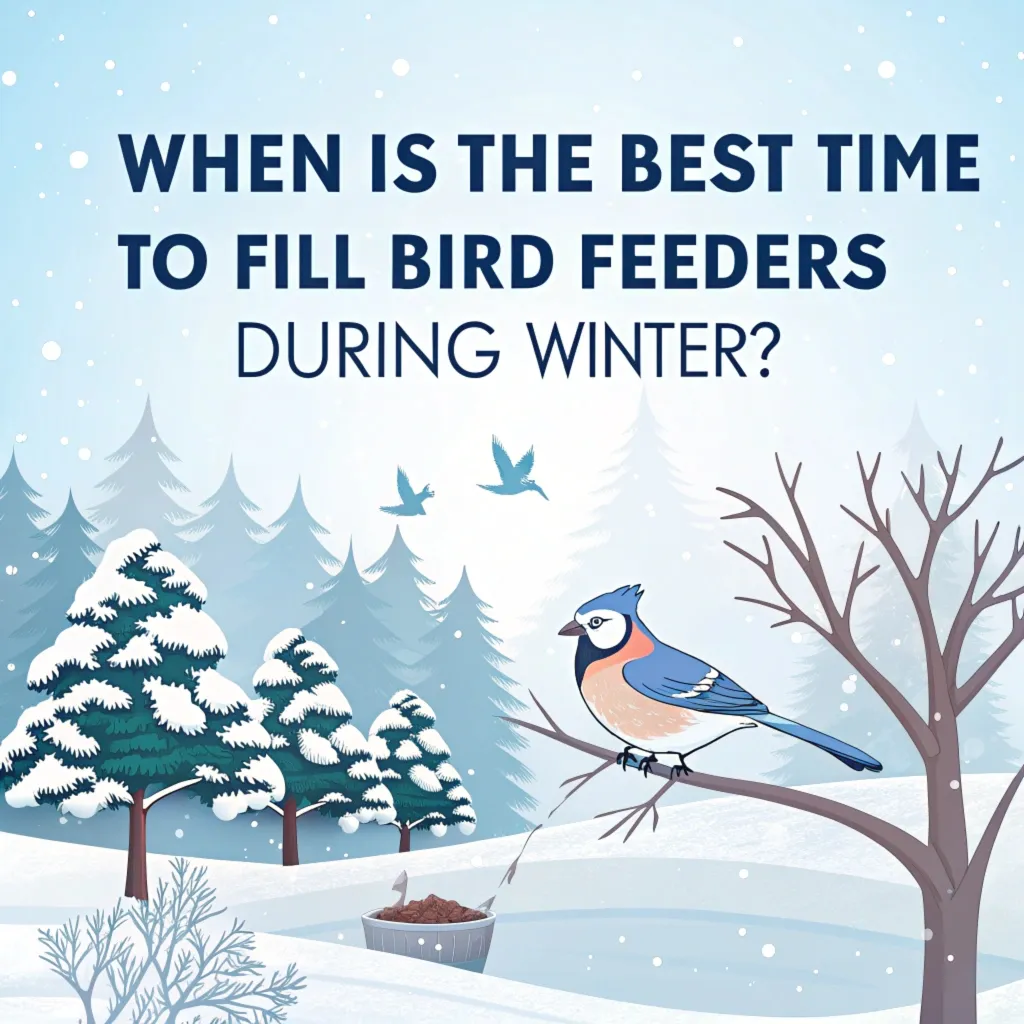
During winter, it’s crucial to refill feeders daily. The high energy demands of birds in cold weather mean they consume more food than in warmer months.
Daily refills ensure a consistent food supply and prevent feeders from remaining empty for extended periods.
Regular monitoring of feed levels is essential, especially during severe weather events. Birds may consume more food during storms or extreme cold, requiring more frequent refills. Establishing a routine check of your feeders can help ensure birds never find them empty.
Consistency in refilling also helps build trust with local bird populations, encouraging regular visits to your feeding stations. A reliable source of food will attract more birds over time, creating a lively atmosphere in your yard.
Types of Food to Offer in Winter
Winter bird feeding should focus on high-energy foods that help birds maintain their body heat. Some excellent options include:
- Black oil sunflower seeds: High in fat and easy to crack open
- Suet: Provides concentrated energy and attracts a variety of birds
- Peanuts: Rich in protein and fat
- Nyjer seeds: Favored by finches and other small birds
- Mixed seed blends: Offer variety and attract different species
Nutritional diversity is key in winter feeding. Different bird species have varying dietary preferences and nutritional needs.
Offering a range of food types ensures you’re supporting a diverse bird population and providing comprehensive nutrition.
Consider adding seasonal treats like dried fruits or mealworms, which can also attract insectivorous species during winter months when insects are scarce. These additions can enhance your feeder’s appeal and provide essential nutrients that birds need for energy.
Importance of Water Sources
Providing fresh water is as crucial as offering food. In winter, natural water sources often freeze, making it difficult for birds to find drinking and bathing water.
Consider using a heated bird bath or regularly replacing frozen water to ensure birds have access to this vital resource.
Water availability can be a significant factor in attracting birds to your yard. Even in freezing temperatures, birds need to drink and bathe to maintain their feathers for effective insulation. A reliable water source can make your feeding station a preferred spot for local birds.
Additionally, keeping water sources clean prevents algae growth and ensures that the water remains appealing for drinking and bathing purposes throughout the season.
Proper Feeder Placement
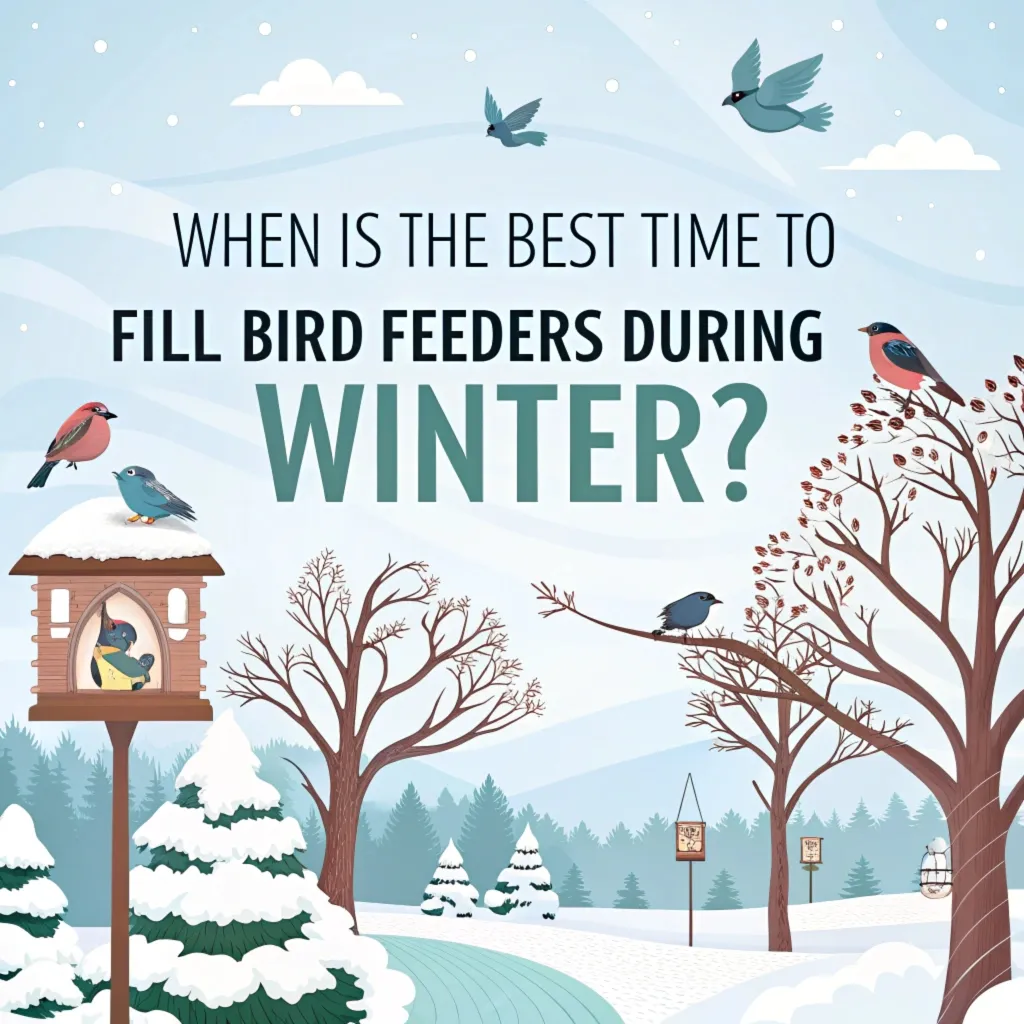
Place feeders in sheltered areas that provide protection from harsh winds and predators. Ideal locations include near evergreen trees or shrubs, which offer natural shelter.
Ensure feeders are 8-10 feet away from these protective areas to give birds a clear view of potential threats.
Strategic placement of feeders can significantly impact their effectiveness and safety for birds.
Consider factors like sun exposure, which can help keep seeds dry and provide warmth for feeding birds. Also, think about visibility from your home if you enjoy bird watching.
It’s also beneficial to place multiple feeders at different heights or styles around your yard. This diversity allows various species with different feeding habits to access food comfortably without competition.
Maintaining Clean Feeders
Regular cleaning of bird feeders is essential to prevent the spread of diseases. Clean feeders every two weeks using a solution of nine parts water to one part bleach. Scrub away debris and dry thoroughly before refilling.
Hygiene is paramount in bird feeding. Dirty feeders can become breeding grounds for harmful bacteria and fungi, potentially causing outbreaks of avian diseases. Pay special attention to areas where seed accumulates, as these can become damp and moldy.
Consider having multiple sets of feeders so you can swap clean ones in while others are being sanitized. This practice ensures that you always have functional feeders available while maintaining cleanliness standards.
Adapting Feeding Practices to Weather Conditions
During severe weather events, such as snowstorms or extreme cold, birds may require additional support. Increase the frequency of feeder checks and refills during these periods.
Consider offering extra high-energy foods to help birds cope with the increased energy demands.
Weather awareness is crucial for effective winter bird feeding. During storms, birds may feed more intensively in preparation for periods when foraging is difficult.
Be prepared to increase food offerings and clear snow from feeding areas to maintain accessibility.
Keeping an eye on weather forecasts allows you to anticipate changes that may affect local bird populations, ensuring you’re always prepared with adequate supplies at your feeders.
Starting and Ending Winter Feeding
Begin your winter feeding routine in late fall to help birds prepare for the colder months ahead. Continue feeding consistently throughout winter and into early spring.
Gradually reduce feeding as natural food sources become more abundant, typically in late March or early April.
Starting your feeding routine early helps establish a reliable source of nutrition just as temperatures drop significantly. It’s essential not only for survival but also helps local birds acclimate better as they transition into harsher conditions.
As spring approaches, gradually reducing feed encourages birds to return their focus on natural foods while still offering them support until they fully adapt back into their seasonal diets.
Attracting Different Bird Species
To attract a diverse range of birds, offer a variety of food types and feeder styles. Use tube feeders for seeds, platform feeders for larger birds, and suet cages for woodpeckers and other clinging birds. This diversity will create a more vibrant and interesting backyard bird community.
Understanding local bird populations can help you tailor your feeding strategy effectively based on what species frequent your area most often throughout winter months—this knowledge allows you better opportunities at attracting specific favorites!
Experimenting with different feeder types not only provides variety but also enhances your chances at observing different species interacting within your yard’s ecosystem throughout this season!
Dealing with Non-Target Animals
In some areas, bird feeders may attract unwanted visitors like squirrels or bears. To minimize this issue, use squirrel-proof feeders or consider bringing feeders in at night if bears are prevalent nearby—alternatively use feeds less attractive specifically designed towards deterring these animals!
Managing non-target animals requires balancing deterrence while still appreciating wildlife present around us; some creatures may be problematic but others might enrich our experience!
Using baffles on poles keeps climbing animals from accessing seed while allowing smaller songbirds safe access without interference from larger mammals nearby!
Being aware of local wildlife regulations regarding animal interactions helps ensure we’re following best practices while enjoying nature responsibly!
The Impact of Winter Feeding on Bird Populations
Consistent winter feeding can have a positive impact on local bird populations by improving survival rates during harsh weather conditions while helping them maintain better condition leading into breeding seasons ahead!
However it’s important not forget that these resources should supplement rather than replace natural ones available within ecosystems surrounding us!
Research has shown that winter feeding influences behaviors among certain species; it may lead changes migration patterns observed among some groups while positively impacting breeding success rates come springtime!
Responsible practices contribute valuable insights into citizen science efforts by providing data regarding avian populations observed year-round!
Supporting our feathered friends through responsible practices enriches both our lives as well as theirs—creating lasting connections between humans & nature!
Frequently Asked Questions
How often should I clean my bird feeders in winter?
Clean bird feeders every two weeks using a solution of nine parts water to one part bleach; scrub thoroughly before refilling after drying completely!
Can feeding birds in winter prevent them from migrating?
No—feeding does not interfere with migration patterns; changes occur primarily due lengthening daylight hours rather than availability alone!
What time of day do birds feed most in winter?
Birds tend toward peak activity at feeders during early mornings & late afternoons—stocking up needed energy reserves before long cold nights ahead!
Should I stop feeding birds if I go on vacation in winter?
If possible arrange someone else continue filling those stations; abrupt cessation could harm those relying upon those resources regularly provided previously!
How can I keep bird seed from freezing in the feeder?
Use covered designs protecting contents from moisture accumulation; adding small amounts corn syrup prevents clumping even under freezing conditions!
By following these guidelines, you can create a welcoming winter haven for birds in your backyard! Remember—consistent & responsible practices not only help them survive harsh months but also provide joy observing resilient creatures up close!
Winter bird feeding becomes more than just hobby—it connects us deeply within nature while contributing positively toward well-being local ecosystems surrounding us!

Luna is the passionate founder and author of Birds and You, a website dedicated to sharing her love for birds with fellow enthusiasts. Through her engaging articles and guides, she aims to educate and inspire others to explore the fascinating world of birds. When she’s not writing, you can find Luna observing birds in their natural habitats or sharing beautiful bird photography on Pinterest. Join her on this journey to celebrate and protect our feathered friends!




